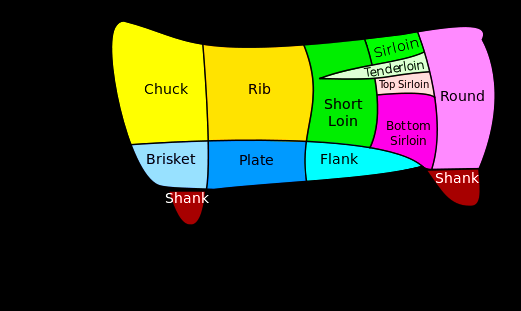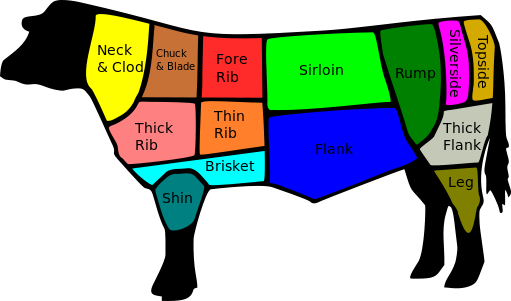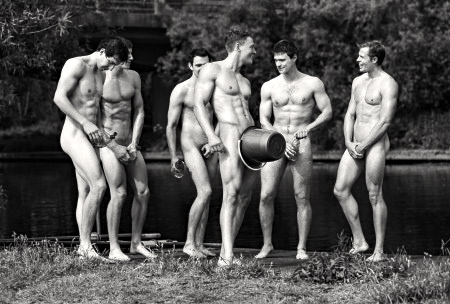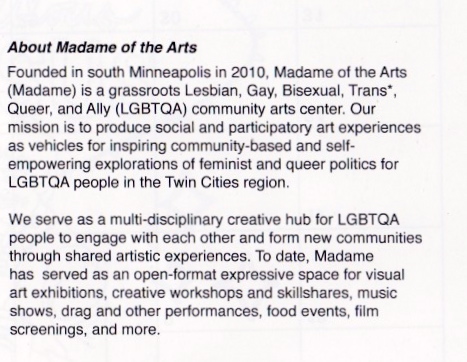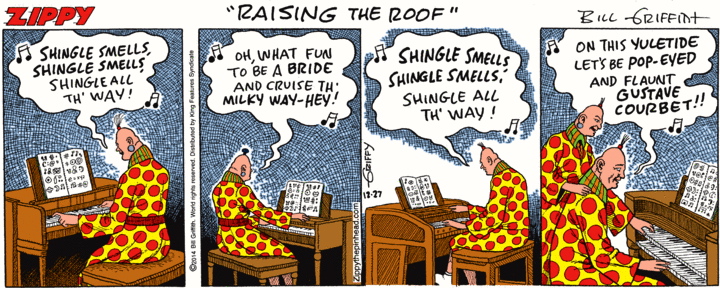I discover that I never posted the handout for my 2012 Stanford Semantics Festival talk, “Parts of the Body”. Here it is, somewhat belatedly (and with somewhat awkward formatting):
Parts of the Body
Arnold M. Zwicky — Stanford Semantics Festival 13 – March 16, 2012
1. Is the armpit (or underarm) a part of the body? Yes and no. It’s certainly an (external) area of the body, but when you ask people to name parts of the body, the armpit rarely comes up; it’s not a basic part of the body.
1.1. 10 web sources on body parts / parts of the body. One example:
![]()
Group A, comprising parts with 5 or more mentions out of a possible 10:
10: knee, leg
9: ear, elbow, head, mouth
8: arm, eye, foot, hand, neck, shoulder
7: finger(s), nose, toe(s)
6: abdomen / belly / stomach, ankle, chin, wrist
5: bottom / bum / buttocks, breast, calf, cheek, forehead, thigh, thumb
Group B, the dividing line between high frequency and low-frequency items, with only Adam’s apple (4 mentions) in it;
Group C, with 1-3 mentions (3: 7 items; 2: 11 items; 1: 21 items); among the items:
sexual parts: penis, vagina, scrotum, clitoris
regions (larger areas): face, chest, back, groin
parts of parts: heel, teeth, forearm, jaw, nostril, tongue, eyebrow, finger nail, knuckle, lip
armpit: only one mention; no mentions for underarm, or of course for axilla
1.2. A folk understanding of the body and its constituents, in which internal contents (in particular, organs) are distinguished from external features, and the latter include both parts proper and areas, with regions (as above) distinguished from smaller areas
On concavities:
“English vocabulary [is] poor in words for concavities (though usually there are technical terms in anatomy for these areas), while being rich in words for areas of the body that project (nose, ears, lips, fingers, toes, elbows, knees, nipples, and so on).”
ex.: the area (or web) between the thumb and forefinger, which has a label [roughly ‘tiger’s maw’] in everyday Chinese (Victor Mair). Phrasal expressions in English, like area between the thumb and forefinger; anatomical (and phrasal) first interdigital space; semi-technical (and metaphorical) term ditch used by tattoo artists; note “the significance of this area in martial arts and acupuncture: it’s the site of an important pressure/acupuncture point. So it would make sense for Chinese to have a label for it.” (from “Concavities”)
exx.: inside of the elbow (cubital fossa, elbow pit), inside of the knee (popliteal fossa, knee pit): no everyday, widely used, non-slang, non-phrasal expressions
similarly, perineum, with various slang alternatives (like taint), and with an ambiguity between the broad sense of perineum (taking in the genitals and the anus) and a narrow sense (“the surface skin region between the anus and the scrotum or vaginal opening” – Wikipedia entry)
But there is armpit:
– Wikipedia: “The axilla (or armpit, underarm, or oxter) is the area on the human body directly under the joint where the arm connects to the shoulder.” [oxter is N. English or Scots]
– OED2: The hollow under the arm where it is jointed to the trunk.
– AHD5: The hollow under the upper part of the arm at the shoulder.
Note: “area” and “hollow”.
2. Even if you concede that the armpit’s a part of the body (with part ‘portion’), you might be unwilling to say that it’s a bodypart.
2.1. A distinction in the way compound nouns (like bodypart) and phrasal expressions (like part of the body) tend to be interpreted.
Compounds tend to pick up specialized senses, so that they’re not always fully compositional: bodypart can function as a “semi-technical” term in a way that part of the body usually doesn’t (bodypart / body-part / body part isn’t in standard English dictionaries – OED, NOAD, AHD, for example — though it probably should be, along with the many other body- compounds these dictionaries list).
2.2. A related case: the OED’s Word of the Year for 2011, squeezed middle:
“a UK Labour Party politician’s feeble phrase for denoting an allegedly squeezed and put-upon class trapped in between the welfare riff-raff below (well taken care of with luxury soup kitchens and lavish handouts of cash, as is well known) and the fat-cat billionaires above.” (Geoff Pullum)
GKP continues:
“But my real objection is not to the feebleness and blatantly political origin of this phrase (which ordinary people are simply not using), but to the fact that it is fully compositional: squeezed just means “squeezed”, and middle just means “middle”, and if you put the two together you have the literal meaning. It is ridiculous to think of putting this in a dictionary — as opposed to a collection of political phraseology and cliché.
Oxford University Press has defended itself against such charges by issuing this FAQ response: “From a dictionary-maker’s point of view, a two-word expression is called a ‘compound’ and is treated as one word [a 'headword'] in the dictionary.” Nonsense. This is not a compound. It is an ordinary nominal with a participle functioning as attributive modifier of a noun. OUP needs a competent in-house grammarian.”
Four issues here: (1) squeezed middle as word or phrase; (2) its status as a compound; (3) its compositionality; (4) hence, its suitability for listing in a dictionary. Subsequent discussion argues: (1) a phrase; (2) not a N + N compound, but an Adj + N composite; (3) not necessarily fully compositional; (4) hence, a candidate for listing in a dictionary. The run-down: Ben Zimmer, “WOTY need not be a word”:
“I agree with Geoff that the press release from Oxford Dictionaries erred in explaining squeezed middle as a compound. Nonetheless, I think that a compositional phrase can be sufficiently lexicalized for consideration as Word of the Year — especially when a dictionary is making the selection. Though Geoff argues that it’s “ridiculous to think of putting this in a dictionary,” dictionaries from the OED on down are in fact full of such phrases. Sometimes they are lemmatized separately, and sometimes they appear in so-called “run-on entries” — so that an ADJ-N phrase can be found under the head noun.”
Mark Liberman weighs in:
“Like Geoff and Ben, I was puzzled by choice of “squeezed middle” as the OED’s WOTY. But I agree with Ben that it’s reasonable as well as traditional for dictionaries to include semi-compositional compounds and phrases among their entries. In such cases, a word-combination X Y has a common meaning that’s an unpredictable specialization of its compositional meaning, so that you may not be able to figure out what X Y means, even in context, and you’re even less likely to be able to guess that X Y is the term that you should use to convey the concept in question.”
Note “semi-compositional” and “unpredictable specialization of its compositional meaning”. As with Adj + N squeezed middle, so with N + N bodypart.
And then Mark suggests a playful resolution of the dispute, POTY in addition to WOTY:
“Why can’t we all get along? Let’s end the argument about whether the Word Of The Year should sometimes be a phrase by having a separate competition for Phrase Of The Year.
And we can divide the POTY prize further into two categories: one category for phrases that remain entirely compositional in meaning, but are newly-common terms for newly-popular concepts; and another category for newly-popular phrases whose common usage is an opaque metaphorical or metonymic extension of its basic compositional meaning.
This doesn’t end all possible arguments — the boundary between words and phrases is historically as contested as the boundary between Germany and Poland or Armenia and Azerbaijan.”
Mark then offers texting glove as a candidate for POTY.
2.3. Bodypart as a semi-technical term. In addition to clearly technical terminology (used in some conceptual domain, among an expert community of users, for some explicit purpose) and clearly ordinary language (expressing folk categorizations, for everyday purposes), there’s a middle zone of semi-technical terminology, which arises from at least two motives: lexical enhancement (creating expressions, using existing resources of the language, for categories that have no ordinary-language label) and lexical refinement (specializing some existing variant, so as to restrict its sense for particular purposes or to convey associations with particular contexts of use or communities of users).
2.4. Some examples of lexical enhancement.
2.4.1. personal pleasures (anal beads, bondage gear, buttplugs, cockrings, condoms, dildos and vibrators, lubrication) and other terms for commercial categories (like cookware), discussed here:
“… The point is that for a significant part of 10 Per Cent’s readership, the items listed above make a kind of natural — well, actually, cultural — category, of items that can be used in sexual encounters (in particular, gay sexual encounters), especially to enhance the sexual experience. The problem is that ordinary English doesn’t have an expression devoted to covering this territory. So people proposing to sell these items create one — an expression that will serve as a kind of “semi-technical term”, not as rigidly tied to its referents as scientific and legal and other sorts of specialized vocabulary, but also not just everyday language.
… like entirely ordinary terms with social or cultural content, these semi-technical terms are subject to considerable fuzziness around the edges — it’s as absurd to spend time trying to decide what REALLY counts as cookware as it is to decide what REALLY counts as a cup (on cups, see Labov’s “The boundaries of words and their meanings”, in Bailey & Shuy, New Ways of Analyzing Variation in English (1973)) — and to considerable variation: different people have somewhat different semi-technical terms, even for the same referents, and even when they have the same terms, they don’t use them in quite the same ways (what counts as cookware for you might not be quite the same as what counts as cookware for me).
… like indubitably technical terms, semi-technical terms have a way of insinuating themselves, on occasion, into ordinary language.
… Commercial categories, and their associated labels, can also slip over the line. Normally, you might say, “I bought some beautiful flatware at Crate and Barrel” (evoking the specifically commercial context) and would not say, to a family member, “Sandy, it’s time to set the table; please put out the flatware” (instead, you’d say, “knives, forks, and spoons”), but there are situations where you might use the semi-technical term: “We have 500 people coming to the reception; Terry, would you take care of the flatware?”.”
Follow-up here, stressing variability in usage and the traffic between ordinary and technical usage:
“The comments on my posting “Commercial categories” struck me as useful, and also fascinating. They illustrated my observation that though technical, semi-technical, and everyday uses of expressions can be distinguished, these uses aren’t fixed in stone, but can vary from person to person and time to time; and that both what’s included in a category and also the label that’s used for that category can vary in the same way.”
On the two-way traffic, note the “technicalization” of ordinary vocabulary in some domains –- mass in physics, group in mathematics, bug in entomology — and the “ordinarization” of technical vocabulary in others (as when penis and vagina have been taken from anatomical language to serve as neutral terms in everyday language).
2.4.2. bodily / personal hygiene, here:
“Some of the variation in usage no doubt arises from the fact that bodily hygiene and personal hygiene are “semi-technical terms”, not really part of everyday English, which are pressed into service, essentially by stipulation, to refer to categories that have no simple everyday labels.”
2.4.3. A-shirts and I-shirts, here:
http://arnoldzwicky.wordpress.com/2010/05/01/define-scrimmage-t-shirt/
“There are A-shirts (this seems to be a semi-technical term), which have neither sleeves nor a neckband and encompass both tank tops and garments variously called wife-beaters, singlets, vests, or some offensive things like Guinea tees and Dago tees (from their presumed Italian origins); your classic (full) T-shirts; and I-shirts (another semi-technical term), T-shirts with their sleeves missing.”
2.4.4. (action) figure, here:
“Both have figure used as at least a commercial term for a species of toy, covering both dolls and action figures; it’s not clear whether this commercial, semi-technical, usage is limited to those that have movable parts (where do toy soldiers, Indians, etc. stand?), though it does seem clear that it’s limited to human or humanoid representations (teddy bears, etc. are out, even if they’re in military costume).
We can see here some hint of a folk taxonomy in the domain of playthings, with toys, games, figures, and stuffed animals as subcategories (where do those trading cards in the 2002 cite above come in?), and with dolls and action figures as subcategories under figures. Not all of the taxa have established ordinary-language labels, the folk taxonomy might not align entirely with the semi-technical taxonomy adopted in commercial contexts — in some contexts in commercial law, action figures are a species of doll (see the passage below from the OED draft addition of 1993 under Action Man), though most speakers would, I think, reject that use of doll in everyday language), and there is probably considerable variation in the taxonomies and the vocabulary, variation being the norm in such matters.”
2.4.5. Labels in the SIP domain (sexuality, sexual identity, sexual practices), here:
“In domains of sociocultural significance – foodstuffs and clothing are two others I’ve looked at – we see several common themes:
(1) There are folk categories and any number of more technical or specialized categorizations,
(1a) each serving some purpose (the categories serve a role in, for instance, welcoming people to Pride events, speaking to them for social-service purposes like AIDS prevention, creating groups for political action or socialization, etc.),
(1b) and each grounded in some set of beliefs and attitudes (in this case, medical, legal, religious, psychological, etc.).
(2) The lines between these are permeable, with categorizations moving back and forth between contexts of use and changing in time.
(3) The categories don’t cover the domain fully and aren’t always mutually exclusive.
(4) Though some of these categories are labeled, in ordinary or (semi)technical language, many taxons (especially the larger taxons, like SIP) are unlabeled.
(5) Ordinary speakers (and, usually, “scientific” or other specialized analysts) have access to the categories only through the labels, and are likely to assume that the labels are the categories (gay “means” so-and-so), to analytic and social confusion.
(6) The categorizations (and accompanying labels, as in the putative basic vocabulary in the initialism above) compete with one another and are often at cross purposes.
(7) The categorizations, especially at the higher levels, may be in dispute: do they represent (socioculturally or psychologically) real groupings?
(8) The labels pick up associations (or connotations) from their contexts of use, at least as individual speakers experience these, and so are promoted or disfavored.”
2.4.6. erection enhancer, here:
“Out has opted for a category in between classic cock rings and sex toys in general: the category of things designed to increase erections, for which the magazine uses the semi-technical term erection enhancer, a synthetic compound in –er”
2.5. Lexical refinement. In bodypart, we see a tendency towards specialization of the N1 + N2 compound (otherwise just an alternative to the fully compositional N2 + PP variant part of the body). Both N + N compounds and Adj + N composites – especially those, like conjugal visit, that involve pseudo-Adjs – are inclined to develop specialized senses. (On conjugal visit, see here.)
3. Parts of the body as a resource in semantics and pragmatics. The vocabulary of the body and its constituents provides a rich source of illustrations of semantic and pragmatic phenomena. Many of these were mentioned above and are discussed in more detail in my posting on vulva and vagina, here.
3.1. A covert taxonomy for conceptual domains (internal organs vs. external features; bodyparts vs. areas vs. large regions, like the lower body); some things are largely outside of this taxonomy (hair, bodily fluids).
3.2. A distinction between ordinary and technical language (in this case, everyday vs. anatomical terminology), according to the purposes each serves (cf. armpit and axilla); ordinary language focuses on external features, while anatomical language tends to treat these as mere “anatomical landmarks” for locating internal organs. (Elbows and knees are, to the anatomist, really the joints in question and the bones that make them up.)
3.3. Lexical gaps in ordinary language (e.g. for popliteal fossa), filled by phrasal expressions (inside of the knee) or slang innovations (knee pit) (another phrasal strategy is coordination, as in head and neck, arms and legs – cf. aunts and uncles).
3.4. Multiple synonyms, distinguished by pragmatics, social function, or style (umbilicus, navel, belly button).
3.5. Ordinarization: migration of technical terms into ordinary language (penis, vagina), usually to provide neutral terms in socially edgy domains.
3.6. Complex structure of conceptual (and lexical) domains, in particular, a mereology of parts within parts: head > face > mouth > lips.
3.7. A distinction between basic and non-basic categories (and vocabulary).
3.8. Terms understood more narrowly or more widely (eye as ‘the organ of sight’ or ‘taken as including the eyelids, or the surrounding parts; the region of the eyes’ (OED)).
3.9. Considerable variation (social and individual) in categorization and vocabulary.
![]()
![]()
















